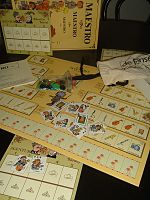Maestro (game)
| maestro | |
|---|---|
 Plan and accessories |
|
| Game data | |
| author | Rudi Hoffmann |
| graphic | Rudi Hoffmann |
| publishing company |
Hans in luck , Casper |
| Publishing year | 1989 |
| Art | Placement game |
| Teammates | 2 to 4 |
| Duration | 20 to 30 minutes |
| Age | from 8 years
|
| Awards | |
|
Game of the Year 1989: Shortlist |
|
Maestro is a tactical placement game by Rudi Hoffmann, published in 1989 by Hans im Glück Verlag , from which the graphics also come.
content
With Maestro, as the leader of a concert agency, the aim is to have as many musicians as possible perform at concerts and to collect points for them. If musicians stay without a performance, you get minus points. In addition to the game board and the instructions, the game box contains:
- four agencies in cardboard form
- a bag of point chips in the values
- 11 × 1 point
- 11 × 5 points
- 20 × 10 points
- 5 × 20 points.
- 71 stable cardboard plates, of which
- 14 applause tokens
- 56 musicians tokens, including 10 depictions of Maestro
- 1 reviewer with stand bracket
The pieces of music printed on the program are all authentic. These are compositions by Bach (1747) via Igor Tscherepnin (1901) to Laura Branigan (1984).
regulate
Each player has a concert agency with a maximum capacity of 10 seats. He accepts musicians of all kinds with normal contracts (5 × upper row) and exclusive contracts (5 × lower row). At the beginning, each player receives a maestro figure (conductor) and places it in his agency in 10th place. All other musicians and the applause cards are placed in an opaque bag, from which 1 to 3 tiles are continuously drawn.
10 pieces of music, ranging from duo to septet, are shown on the schedule and must be cast. Each occupation must begin with a maestro at any point. When casting, the player in turn may also use the agencies involved from the top rows. For every musician who plays in a concert you get points. if a piece can be completely occupied, double the number will be awarded. If you complete a piece of music, you get the critic, who earns 10 points.
Playing
If you draw an applause card , it is placed on the bottom row of the game board. When the last of the 14 tiles is placed, the game ends. Whoever was able to collect the most points by then, minus the musicians who did not appear in the agency, has won. Usually you agree on a winning number (e.g. 200 or 300), so that several games are necessary for the overall victory.
Awards
Maestro received two awards when it was published in 1989:
- It appeared on the shortlist for Game of the Year .
- It achieved 1st place in the award of the Golden Pöppel .
The Swedish edition of Casper was named Årets spel , the Swedish game of the year in 1991 .
New edition
As part of the Mozart year and based on the television series Little Amadeus , Amigospiele released the game in a different design with an additional CD in 2007. Now the pieces of music to be cast were all Mozart compositions.
Web links
- Maestro in the Luding games database
- Little Amadeus Maestro in the Luding games database
- Maestro in the game database BoardGameGeek (English)
- Game instructions (pdf; 63 kB)
Individual evidence
- ↑ a b c Maestro. (No longer available online.) Hans im Glück Verlag, archived from the original on December 20, 2015 ; Retrieved December 6, 2015 . Info: The archive link was inserted automatically and has not yet been checked. Please check the original and archive link according to the instructions and then remove this notice.
- ↑ Årets spel at globetrotter-games.com
- ↑ Maestro at globetrotter-games.com
- ↑ Little Amadeus Maestro ( page no longer available , search in web archives ) Info: The link was automatically marked as defective. Please check the link according to the instructions and then remove this notice. at spieletest.at